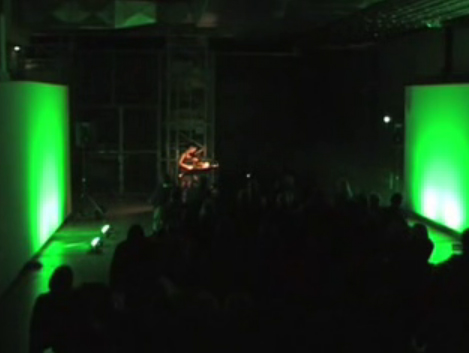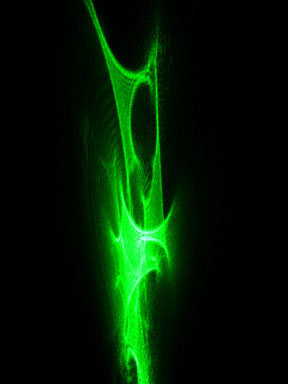In my work with sound and light, I am transferring musical ideas into light designs in order to create an additional channel of sensual communication, which adds to the music in a homogenious way. By doing this, the combinations of light and sound open ways to explore countless possible relationships between the two, that can roughly be grouped in the following three cathegories:
- Doubling of form and development in order to clarify them.
- Formal correspondances that are not aligned in time, therefore creating a
counterpoint-like relationship between the two.
- Conspicuous differences between the two, introducing additional levels of
contrast and contradiction.
The following work is an example for the first instance, the “doubling
of form and development”, although it also contains freer passages that
rather fall into the category of “counterpoint-like relationship”:
“Alias”
(composition for electric violin, live electronics, light and laser)
(featuring Barbara Lüneburg on electric violin)
Notes on the work with a special emphasis on the use and role of the visuals.
“Alias” leans on various techniques that are used by film. I was
specifically interested in the so called “temporal aliasing” effect.
“Temporal aliasing” means that when the eyes are exposed to an image
for a fraction of a second, the brain holds the image for longer than it is
actually visible. As film is based on a fast succession of images, that (at
least in analogue techniques) are seperated by a moment of blackness, caused
by the “shutter”,(1) the “temporal aliasing” bridges
the black gaps and enables us to see the succession of images as a continuous
motion.
What interest me in this context is that stroboscobic effects, namely the fast
succession of visual information which the brain still recognises as single
images, is very closely related to the film technique. It is however perceived
as very stressfull information. It is a thin threshold of speed difference,
that seperates the strenuous sensation of stroboscopic visuals, from the smooth
and continuous reception of film.
While we perceive film as a continuous motion, the sound of a projector still
reveils the mechanisms at work. The rattling of the shutter is clearly recognisable
and its unquietness links closer to that of a strobe.

The fixed frame-rate of film brings along other phenomena that I found interesting
to explore, most notably the so-called “spinning wheel effect”.
Rotating wheels seen on film sometimes appear to move slower, to stagnate or
even to move backwards. This is caused by a quantisation of the visual material,
that the fixed frame-rate entails.
New digital technologies, that quantise images into grids of pixels, bring along
many other quantisation phenomena like the Moiré effect, or distorted
lines. These error are also often referred to as ‘aliasing’.
I have translated such phenomena into the music, by composing repeated patterns
and isolating short moments from them throught gatings, at regular time-intervals.
These gated signals themselves create new patterns, a sort of “aliasing“
of the original pattern.
In “Alias”, I was interested to use acoustic elements that originate
from film in the music, first of all by using, manipulated and processed recorded
material from film-projectors, secondly by applying processings akin to film-“aliasing”
on the electric violin, as described above. In addition to the gating techniques,
I also applied fast tremolo effects on the violin. By superimposing two tremolos
at slightly different speeds, I was able to achieve shifting micro-rhythms that
resemble the phenomenon of Moiré-patterns in digital photography.
Furthermore I am using sound excerpts from japanese Mangas as sound material.
Although cut up and processed, these materials are easily recognised as sounds
that are originating from comic films, which gives film, as a technical medium,
a presence throughout the piece.
Acoustically present, but visually absent, the piece regains a substituting
visual quality by a composition of lighting and graphic laser projections.
The visual setup consists of two lamps that are set up on the far left side
of the stage and two on the right. They are projected onto bright surfaces in
the performance space, or on strokes of white cloth, if the space does not offer
appropriate surfaces to project on.
One of the lamps on each side has green gels (usually L139), the other two magenta
(L328) or pink (L148). The green has a similar colour tone like the laser, which
is also green. Magenta is the complementary colour of green. It is used in order
to create the greatest possible contrast in terms of colour. The performer is
on the left side of the stage, relatively close to the front edge.(2) The laser
is set up so that it projects from a point, close to the performer, diagonally
across the stage area to the back right side of the stage. The laser beams are
supposed to come from a similar direction like the violin bow. Visually it should
appear as an extension of the performer.
One of the most consistent techniques that are used in this piece are gatings
of the violin’s signal, according to changing rhythmic patterns, as described
above. The unprocessed sound of the violin is panned to the left, while the
gated and processed signal is panned to the right. This creates an ongoing left-right
motion of the acoustic signal. It is this spacial polarity that the lamps on
the left and right of the stage are exploring. The magenta/pink lamps are only
used to accentuate certain moments in the piece. During most part of the composition,
only the green lamps are used. Their changes of intensity are usually arranged
in an alternating fashion, so that an illusion of a motion from left to right
is created. For example, the left lamp might decrease its intensity from 100
to 0% while the right lamp increases its intensity from 0 to 100%. The light
thereby “shifts” from the left of the stage to the right.
The following excerpts are discussed in order to exemplify the use of the light.
The principle of alternating increases/decreases of intensity is used for example
from m. 3-24 at varying speeds. While the left lamp is making a wave shaped
increase and decrease of intensity, the right lamp swells to 100% and suddenly
goes down to 0% (saw-tooth shape). At that moment the intensity starts to increase
again on the left side. This creates the illusion as if the light was wandering
from left to right only and not the other way round.
At a later point, m. 71-88 both lamps are synchronised in a saw-tooth shapes
of varying lenghts which gives them a much stronger rhythmic profile.
From m. 216-258 the lamps are again starting in synch with the saw-tooth shaped
change of intensity. Here, hoewever, they are gradually running out of synch.
This principle is also derived from the music, where the patterns that are optained
by the rhythmisized gatings, are often periodised in lengths different from
those of the live part, for example m. 89-102.
From m. 436-471 the lamps are again changing the intensity in saw-tooth shaped
manners, but this time inversed, thus starting with 100% and falling off to
0% and from there swithing to maximum again. At first they are shifted in relation
to each other in irregular ways and going through variations, before they rhythmically
line up again in m. 462. Here the left side keeps the sawtooth shape that starts
with 100%, while the other side uses the original sawtooth shape, starting with
0%. Here, a similar effect of left-right motion is obtained like in the beginning.
The role of the laser is much more prominent than that of the lights. The medium
laser entails a strong intensity and immediately draws attention. It is difficult
to use laser is subtle ways. Luckily, this was also not the function that I
envisioned it to have in this piece.
The laser uses geometric shapes. All shapes are made of horizontal and vertical
lines, neither curved or round shapes are used nor rotations of lines. The used
shapes are:
vertical/horizontal single lines;
vertical/horizontal multiple lines;
squares;
crosses;
single points.
I confined myself to these shapes, as I find them characteristic of the framing
of film, and the grid-based digital quantisations of visual material. With the
laser I am reintroducing a graphic element back into the piece, with a much
higher degree of abstraction than film ever has (exept for some sorts of experimental
film). After the filmic elements have been deprived of their visual content
in this piece and only left their trace as acoustic material, the visual is
reintroduced by abstract laser projections.

The position that the laser takes within this entire subject matter that this
compositions deals with, namely the thin threshold between the strenuous sensation
of stroboscopic visuals as opposed to the homogenious filmic one, carries yet
another aspect. Similarly to film, laser generates the smoothness of a projected
image by speed. While film works with a constant rate of changing images, laser
scans the different curves and lines of its image with a single laser point
at a high speed, so that the image – ideally spoken – appears to
be a static one to the eye. Depending on the quality of the laser projector,
and especially on the size and the complexity of the image, more elaborate graphics
tend to flimmer. This happens when the laser point does not manage to pass all
curves and lines of the image fast enough, so that the image starts to desintegrate
to the eye. In more extreme instances this flimmering can turn into a strenuous
sensation which is analogous to that of stroboscopes.
I consciously used this flimmering quality of the laser as yet another visual
representation of the stroboscopic principles that were transferred into the
music. (3)
Furthermore, the laser fits the eccentric, extroverted and glaring quality of
the manga, which hovers over this piece.
Considering that this is a piece for a solo performer, the laser appears as
an extension of the solistic element. As mentioned above, the laser beam is
also positioned in a place and angle as if it is a prolongation of a violin
bow. It extends the soloists role into the visual realm.
As a consequence, the soloist hardly ever plays when the laser is in action.
Generally speaking, the light and the laser are often synchronised with acoustic
events in this piece. Especially during the longer electronic interlude from
m. 602-619, laser and light are completely linked with the sound. This is also
a reference to the pop-like world of the manga, where sound and visual information
predominantly support and enforce each other, rather than go into counterpoint-like
relationships. As such, light and laser are here clarifying the form of the
composition, and are at certain points propelling into the spectacular.
Notes
1. The shutter in a film projector closes the lens during the moment when one image of a film is pulled through to the next one.
2. Left and right are here always referring to the audiences point of view, which is the traditional nomenclature in audio-design, opposite to light-design.
3. My personal laser, is a very cheap one, that flimmers clearly more than expensive models, because of its lesser speed and precision. Its technical shortcomings are beneficient in this context of this piece.
__________________
Texte und Kommentare zum Labor 2008 werden hier veröffentlicht
Texts and commentaries on the 2008 lab and related research subjects will be published here.